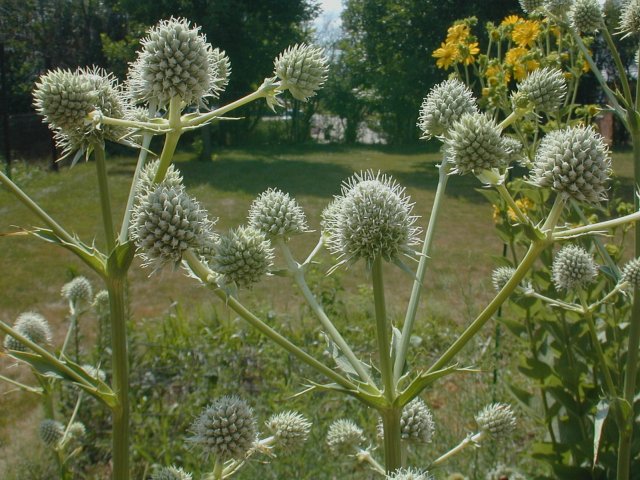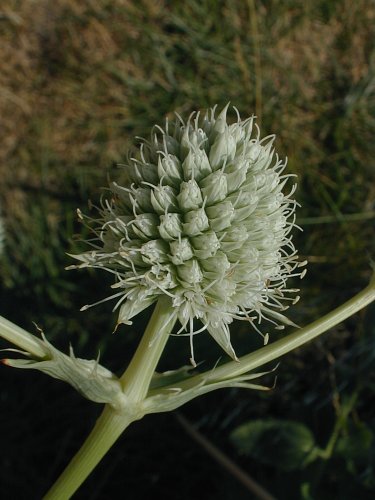Description: This perennial plant is 2-5' tall. It has a stout central stem that is unbranched, except near the inflorescence. The alternate leaves tend to occur near the base of the plant, although a few smaller leaves occur along the upper portion of the stem. These leaves are long and strap-like, rather stiff in texture, and up to 2½' long and 2½" across. They are narrowly lanceolate, often curve downward, and have parallel venation. There are widely scattered, but stiff, teeth along the margins. The base of leaves clasp or wrap around the stalk. The entire plant is bluish or greyish green, and quite hairless. At the apex of the central stem, and sometimes from the axils of the upper leaves, occurs a long-stalked inflorescence. This consists of several prickly balls of flowers that are individually about ½–1" across. These whitish green balls contain numerous small white flowers that are individually surrounded by prickly bracts. A flower consists of 5 white petals, a divided white pistil, and several white stamens with light brown anthers. Each ball of flowers is subtended by a star-like rosette of small leaves. These flowers have a sickly honey-like scent in bright sunlight.

The blooming period occurs from mid- to late summer, and the
balls of flowers remain attractive for about 2 months. The root system
consists of a central taproot. After blooming, a plant will gradually
die down, but one or more offsets will develop at its base. Thus, a
small clump of plants will eventually form.
Cultivation:
The preference is full sun and moist to slightly dry conditions. This
plant becomes spindly in shadier conditions, and may topple over while
in bloom. The soil can contain significant amounts of loam, sand, clay,
or gravel, but the site should not be subject to standing water. This
plant is easy to grow, and isn't bothered by foliar disease nor many
insect pests.

Range &
Habitat:
The native Rattlesnake Master occurs in most of Illinois, except for
some western
and southern counties (see Distribution
Map). It can be locally common in some high quality habitats,
otherwise it is fairly uncommon. Habitats include moist to slightly dry
black soil prairies, clay prairies, sand prairies, thickets, typical
savannas, sandy savannas, and limestone glades.
Faunal Associations:
The flowering heads attract many kinds of insects, including
long-tongued bees, short-tongued bees, wasps, flies, butterflies,
skippers, moths, beetles, and plant bugs. These insects usually seek
nectar, although some of the bees may collect pollen for their brood
nests. The caterpillars of the rare Papaipema eryngii
(Rattlesnake Master Borer Moth) bore into the stems and feed on the
pith. The coarse foliage and prickly balls of flowers are not popular
as a source of food with mammalian herbivores, although they may nibble
off the ends of the leaves.

Photographic
Location:
The photographs were taken at the webmaster's wildflower garden in
Urbana, Illinois.
Comments:
This is a very odd member of the Carrot family that resembles a yucca
or some other desert plant. However, it is a true tallgrass prairie
species with a unique appearance. A close relative is Eryngium
leavenworthii (Leavenworth Eryngo), which is an annual plant
with a purplish appearance. This latter species doesn't occur in
Illinois, but can be found in dry prairies further west. In the past,
the dried seedheads of Rattlesnake Master were used as rattles by
Amerindians. Pioneers thought the roots could be used as an effective
antidote to rattlesnake bite, hence the common name of this plant.
However, this belief was erroneous.